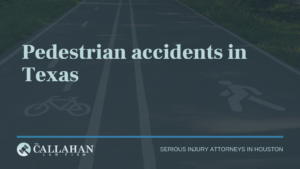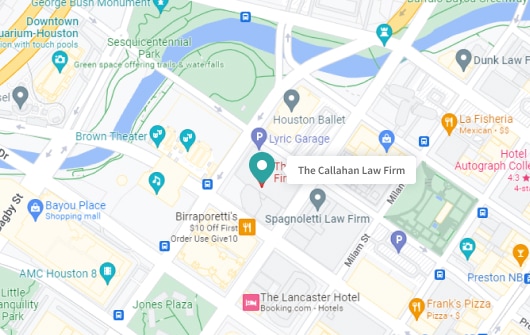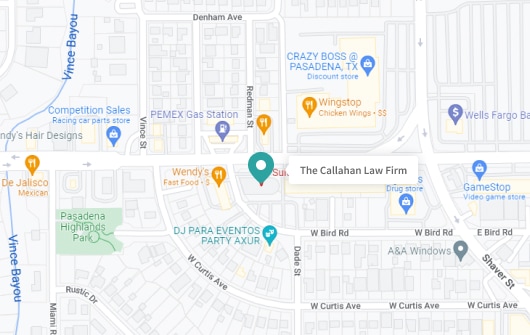Pedestrian Accidents in Texas

According to the Governors Highway Safety Association (GHSA), there were over 6,500 pedestrian fatalities in the United States in 2019. That is the highest number of pedestrian deaths in over 30 years. To put it into perspective, one pedestrian was killed every 81 minutes in 2019.
Most troubling, last year’s spike was not an anomaly. Pedestrian deaths in the United States have been on an upward trend for the last decade.
Drivers or Pedestrians: Who is to Blame?
The answer is not so simple. There can be one of many different root causes and a variety of contributing factors involved in an accident. The undeniable and tragic fact, however, remains: the United States has seen a significant upward trend in the number of pedestrians being killed by motor vehicles every year since 2009, and there is no indication that we will experience a reversal this year.
Cars are often touted by their manufacturers for providing innovative safety features. In 2015, a group of 20 car makers committed to make automatic emergency braking (AEB) a standard across all of their lineups by 2022. Just a few years later, nearly 45% of 2018 model-year vehicles sold in the U.S. were already equipped with that feature. I In 2018, the National Highway Traffic Safety Administration (NHTSA) mandated that auto makers equip all newly manufactured motor vehicles for sale in the U.S. with backup cameras as a standard feature. Both safety features seem to be a step in the right direction.
Driver fault can come in many forms, with the two most frequently cited being distracted driving and impaired driving. In recent years, there has been an aggressive nationwide push to enact laws and to impose harsh fines for distracted drivers, such as those using mobile devices. Dating back even further, the government made drunk driving a serious offense and continues to crack down harshly on impaired driving.
So, Why Do We Continue to See This Upward Trend in Pedestrian Deaths?
The starting point for understanding the increase is that, for decades, the infrastructure build-out in the United States has favored motorized transport, not walking.
Infrastructure Development
The National Association of City Transportation Officials (NACTO), among other organizations, applies a systematic and scientific approach to community development. These city planners, with their innovative designs and exacting solutions for managing pedestrian traffic, are more frequently mandated to build communities that revolve around vehicle transport than providing pedestrian friendly streets. The push away from pedestrian traffic has been so egregious in recent years that some communities have passed laws that, in effect, criminalize walking.
City planners have long had the capacity to build practical and pedestrian-friendly road designs, crosswalks, median islands, and intelligent timing controls to manage traffic flow. However, advocating change in local government requires lobbying, organization, commitment, and financial backing. Unfortunately, non-sensational causes such as pedestrian safety often struggle to garner any sustainable support. The tragic truth is that more pedestrian deaths will likely occur before local governments take meaningful action. Until then, pedestrians will continue to receive only the most basic offerings, such as sprawled-out crosswalks.
Pedestrian usage of crosswalks, overpasses & underpasses
Although pedestrian behavior is difficult to measure, studies indicate that people are generally unwilling to walk very far to reach a crosswalk. Therefore, if crosswalks were the solution, the number of crosswalks at intersections would have to increase exponentially across the country to have any effect. Data suggests, however, that crosswalks may not be a game-changing solution. According to the Insurance Institute for Highway Safety (IIHS), fatalities at intersections accounted for 25% of all pedestrian deaths in 2018. Intersections were even more deadly for those over 70 years old, accounting for 40% of fatalities in the demographic.
Overpasses and underpasses allow pedestrians to avoid motor vehicle traffic and, as a result, can be effective solutions for lowering pedestrian fatalities. City planners often times consider them only as a last resort, though. Depending on the characteristics of the structure, an overpass or underpass can cost anywhere between $500,000 and $4 million. In addition to the more complex construction design than that of a crosswalk, the structures must accommodate all persons, meaning elevator installations and extensive ramp construction for the elderly and handicapped. Moreover, pedestrians will not use them if there is a more direct route available or, quite often, because the enclosed corridors are considered to be centers of criminal activity.
Motor Vehicle Safety Technology
In a recent study published by the Automobile Association of America (AAA), research revealed that performance with the automatic emergency braking systems for motor vehicles was “inconsistent” and that the system was determined to be “completely ineffective at night.”
Considering that over 75% of pedestrian fatalities occur at night, it is more likely that the system has contributed to the spike than mitigated it. Although some cars with the system have been recalled, many others have not and continue to give drivers a false sense of security.
Most pedestrian fatalities occur at night.
Although only 1% of fatally injured pedestrians are struck by the rear of a vehicle, concluding whether the rear camera feature on cars is successful or not is problematic. There is no data on how many of the motor vehicles involved in those fatalities had – or might have been using – rear cameras. Moreover, the NHTSA definition of traffic-related deaths does not include incidents occurring in driveways or parking lots, making any effort at measuring the success of the rear camera feature unreliable.
Distracted and Impaired Drivers
Distracted drivers, typically those using mobile devices, are often blamed for more pedestrian fatalities. The truth is that, although distractions do result in some accidents and fatalities, other countries that have the same level of mobile device usage are not experiencing the large jumps in fatalities that the U.S. is experiencing. Focusing solely on distracted drivers, therefore, is likely to distract from the other underlying problems.
State and local governments, with the exception of Montana, have made a tremendous push to change driver behavior in recent years by mandating some form of hands-free law. Freeways and local streets also frequently have signs encouraging drivers to “Text Later”, while police aggressively enforce the laws.
That said, the most common thread in pedestrian fatalities is alcohol. Research from 2017 revealed that, whether it is with the driver or pedestrian, alcohol at some level was involved in 47% of pedestrian fatalities. Efforts to curb drunk driving have been successful in recent years, with overall fatalities trending lower between 2017 and 2018. Unfortunately, pedestrian fatalities from drunk drivers increased over the same period.
Behavioral change is required for both distracted and impaired drivers. History shows that forced changes in behavior are challenging and slow-moving, particularly in free societies. This is not to suggest that efforts should not be made; rather, expectations should be set that behavioral changes imposed by government will take time before showing any sustainable success.
Other Factors
Another contributing factor to the rising number of pedestrian deaths from motor vehicles comes from consumers’ preference for larger cars and SUVs. The unintended effect of this shift in consumer preference is that, when a pedestrian is hit, heavier cars and SUVs are more likely to be fatal. According to the GHSA, there was a 53% increase in pedestrians killed by passenger cars from 2018 to 2019, while there was an 81% increase in pedestrians killed by SUVs over the same period, despite the fact that pedestrian crashes more frequently involve cars.
What to Do if You Have Been Injured by a Motor Vehicle as a Pedestrian?
Consulting with the right lawyer is paramount, regardless of the perceived extent of injuries in the immediate aftermath of an accident, or whether one party might have appeared more at fault. We are all pedestrians and we all deserve the right to walk without facing extraordinary and unacceptable risks to our safety. If you or a loved one have been injured in a motor vehicle accident, contact The Callahan Law Firm’s experienced car accident attorneys today for a free case consultation.
Contact The Callahan Law Firm For A Free Consultation

Michael S Callahan is an attorney and founder of The Callahan Law Firm. He focuses his practice on representing individuals and families in personal injury cases involving motor vehicle and truck accidents, workplace accidents and defective products. With over 25 years of experience, he is dedicated to fighting on behalf of people whose lives have been forever altered by the negligence and carelessness of corporations and individuals. Originally trained as a mechanical engineer, Michael has been practicing law and fighting for justice for those who need it most since 1994. He is board-certified in Personal Injury Trial Law by the Texas Board of Legal Specialization and a member of various esteemed legal associations. Outside of work, Michael enjoys spending quality time with his family, outdoor activities, and continually striving to improve as a trial lawyer and human being.











